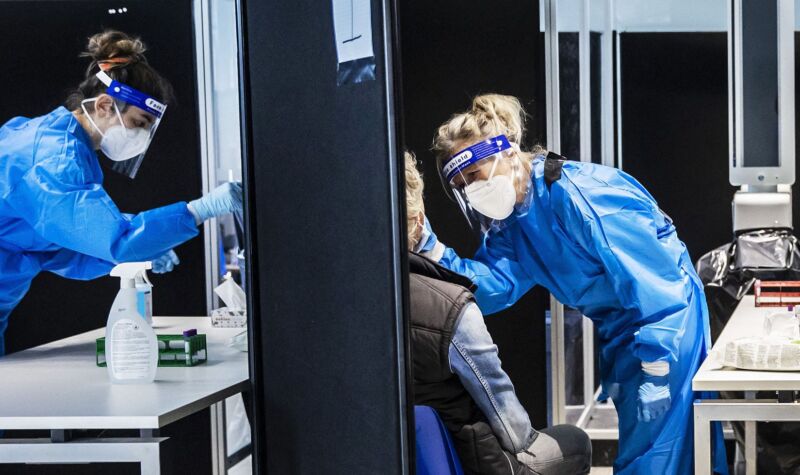Starting last Friday, the race was on—between a virus and information about it. And for a while, the information moved faster, even though there was hardly any of it.
Scientists in South Africa identified a new variant of the virus that causes COVID-19—within days the World Health Organization gave it the spy-sci-fi name omicron—and because of the abundant smorgasbord of mutations in its spike protein, the nanomechanical tentacle that attaches and cracks into cells, science alarms started going off.
But to be clear, they were the "We should check this out" alarms, not the "Everybody lose their effing minds" alarms. Apparently they sound alike, though. Panic took flight as scientists identified omicron in 18 countries, triggering travel bans, border closures, stock market crashes, and, in the United States, holiday weekend worries that the world was headed back to March of 2020. Researchers in South Africa and Botswana have found the most cases thus far, though that may be an artifact of looking for them; on Tuesday, Dutch authorities announced that the earliest case they can identify is 11 days old, predating omicron's identification in South Africa.
That means the omicron variant is widespread and mysterious—a palimpsest wrapped in a hologram draped in a Rorschach test—because nobody knows nothin' yet. Public health authorities can't yet say whether it is more virulent or more transmissible than delta, which since last summer has crowded out most other variants of SARS-CoV-2. So panic; or don't. That's on you. Because now scientists have to work the problem.
The things scientists don't know, but need to: how efficiently does omicron move from person to person? Can it evade the immunity conferred by prior infection, or by vaccines? Does it cause more serious illness? "We need multiple types of data," says Angela Rasmussen, a coronavirologist at the Vaccine and Infectious Disease Organization-International Vaccine Centre in Saskatchewan, Canada. That means getting genomic and epidemiological data, understanding the variant's immunological differences, and collecting stats on breakthrough infections and hospitalizations.
That's all going to be complicated, because a crucial piece of information is missing: How long omicron has been spreading around the world. That new Dutch data suggests it has been longer than health planners first hoped. Whether this is the beginning of a wave—or the middle or end of one that no one noticed—is key. "It appears to have been caught at the beginning of an upswing, at a time where everybody has been focused on delta," says John Connor, a microbiologist at Boston University and investigator at its National Emerging Infectious Diseases Laboratories. "The nice part about having that information early is that the rest of the world can start examining all the questions that are raised by a new variant: Do our diagnostics still work? Does it look like the immune response generated by vaccines can still neutralize this virus?"
If this is just the beginning, let's say, then everyone with omicron might still be one tight-knit group, demographically or biologically speaking. That might make the variant seem more dangerous—faster-moving or making people sicker—if that group was for some reason more vulnerable than the general population. Or the opposite might be true. To figure that out, disease dynamics researchers might do "forensic accounting" to see how prior waves like delta behaved, and compare that to what's happening with omicron. That might say something about whether they're under- or overestimated how bad an omicron wave could be. "If I were to have assessed delta using only the time period that corresponds to about now, how wrong would I have been?" says Matthew Ferrari, director of the Center for Infectious Disease Dynamics at Penn State University.
In short: based on early data, scientists knew very little about delta. Now they know it inside out. They'll need the same patience to understand omicron. As a first step, more details of the variant's genetic structure, initially generated by scientists in South Africa, might help with early ideas about the variant's behavior as it spreads. "One can then infer from the genetics as to how this virus may escape antibody neutralization, whether it will escape vaccines or not," says Deenan Pillay, a virologist at University College London. But that's all inference, he adds: "One can never know, but one can make a calculated assessment based on what we know about the genetics of other variants."



3175x175(CURRENT).thumb.jpg.b05acc060982b36f5891ba728e6d953c.jpg)

Recommended Comments
There are no comments to display.
Join the conversation
You can post now and register later. If you have an account, sign in now to post with your account.
Note: Your post will require moderator approval before it will be visible.